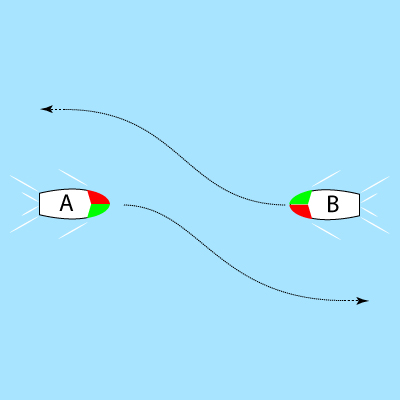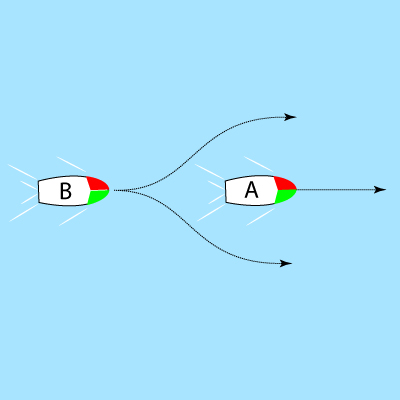Introduction to Collision Regulations - There is a risk of collision, what do we do now? (two power driven vessels in sight of each other)
Caution:
- The following information has been simplified so we can give you a basic introduction using (mostly) non-technical language. Review the actual Regulations for in-depth information (we have noted the rule number, in square brackets, where practical). The Regulations can be found on our links page.
- A lot of effort has been made to ensure the information is correct, but errors may occur (If you find one please leave a message for our Webmaster).
- This information is intended for boaters on the BC Coast; it does not address modifications for vessels operating in the Great Lakes Basin.
- These diagrams are not to scale. To allow both vessels to be seen in the graphic, they have been moved much closer together than is safe in the real world.
- The suggested course alterations shown in the diagrams are also not to scale and only give an approximate indication of what is required.
- These situations are very basic. They are simulating open water encounters, with only two straight forward power driven vessels (neither restricted in ability to manoeuvrer, etc.) There are no other vessels, navigation hazards, currents, narrow channels, traffic separation schemes etc. to take into account.
The following is based on vessels being within sight of each other. See Action on risk of collision in restricted visibilty otherwise.
Once it has been determined there is a risk of collision, in most cases, the Collision Regulations require one vessel to do something to avoid the collision (the "Give Way" vessel), while the other vessel continues its course and speed (the "Stand On" vessel). However there is one situation where both vessels have to do something to avoid the collision. We will deal with it first.
Head-on situation
[Rule 14]

In this case both vessels are required to take action. Both alter to Starboard as shown by the black lines.
Crossing Situation.
[Rule 15]
 or
or 
In these cases vessel B has vessel A on its starboard side, inside the arc of its starboard sidelight, which runs from dead ahead for 112.5 degrees. Under the Collision Regulations, this makes vessel B the give way vessel, who must take avoiding action. Vessel A has Vessel B on its port side, so it is the stand on vessel. (The arc of your green light is sometimes called your danger zone. Another way of thinking of this, is that Vessel A is showing B a red light, and Vessel B is showing A a green - like a traffic light telling vessel A it is your turn to go.)
Overtaking
[Rule 13]

We didn't look at this when we looked at situations to assess risk of collision, but again use of relative bearings during the approach will show whether there is a risk of collision. Note that B doesn't have to be directly behind A for the overtaking rule to apply. Approaching from anywhere in the arc of the sternlight (the sector not encompassed by the sidelights) is considered overtaking..
Vessel B is required to stay clear of Vessel A until past and clear, even if A alters course. Vessel B can overtake on either side of A.
Manoeuvring and Warning Signals
[Rule 34]

One short blast (approx 1 second) - I am altering my course to starboard
Two short blasts - I am altering my course to port
Three short blasts - I am operating astern propulsion
Five short blasts - I fail to understand the your intentions, or I am in doubt you are taking sufficient action to avoid collision - also known as the Danger Signal
One prolonged blast (approx 4-6 seconds) - on approaching a blind corner (to be answered with same signal by other approaching vessel). Or by a vessel of over 12m in length when leaving dock or berth.
Return to Basic Introduction to the Collision Regulations
